Abstract
Mangrove forest is one of the productive ecosystems that provide essential habitats for various fauna as breeding and feeding drives. However, heavy metal pollution in the mangrove forest has led to severe health problems for several aquatic species. Biomonitoring of metals using a nondestructive method is an emerging technique. Scats of the fishing cat (Prionailurus viverrinus) were collected from five locations in the Godavari estuary mangrove habitats, Coringa Wildlife Sanctuary, Andhra Pradesh, India, to determine the level of various metals. An opportunistic method was applied to collect scats in the mangrove forest. Six scat samples were collected from each of the sampling sites. The following prey species, such as crabs, fishes, birds, rodents, plants, plastics, and unidentifiable prey matters, were found in the scats. Select metals, such as chromium (Cr), copper (Cu), and lead (Pb) were analyzed from the scats of the fishing cat since they intensively influence the physiology and behavior of top predators. The concentration of Cu in fishing cat scats was higher than the other two metals assessed. Metals showed statistically substantial variation across locations (p < 0.05). According to the current study, heavy metals may significantly threaten the fishing cat in the Coringa Wildlife Sanctuary. The fishing cat is a vulnerable species in accordance with the ICUN categories. Due to pollution and other human pressures, the fishing cat may soon be categorized as a threatened or endangered species; the research advises that authorities should prioritize the protection of the vulnerable species of the fishing cat from the Coringa Wildlife Sanctuary, Andhra Pradesh, India.
1. Introduction
Metals are a class of non-biodegradable contaminants that cause extensive ecological damage by accumulating in aquatic ecosystems and posing substantial health risks to various organisms [1]. Evaluating heavy metals in the aquatic environment is crucial to comprehend the toxicity of metals and their effect on aquatic life. Countless animal species rely on mangrove forests for sustenance and shelter, making them an essential aquatic environment. Mangrove forests have been shown to play an important role in the lives of many animal species [2]. The eastern coast of southern India is home to one of India’s biggest mangrove forests, the Godavari forest. The Godavari mangrove forest has major ecological and biological functions in its estuary locations [3]. Due to its importance as a marine ecosystem, the Godavari mangroves have been declared as a “Coringa Wildlife Sanctuary.”
The Godavari mangrove is home to a variety of fishes, rats, and other prey species, and the dominant carnivore predator in this ecosystem is the Prionailurus viverrinus. The fishing cat Prionailurus viverrinus heavily uses the estuary mangrove forests of Godavari as a food source and a place to raise their young [4]. However, the decline of Prionailurus viverrinus numbers and their location remain as mysteries [5]. Moreover, the research mentioned little about the population and current location of the fishing cat, since very little has been learned about their status in the sanctuary [6]. Indeed, the fishing cat faces major problems owing to changes in the terrain, loss of their habitat, poisoning, overfishing, poaching for fur and road kill, and other aquafarm practices near their feeding and breeding habitats [7,8]. Meanwhile, a 2016 population study conducted by the International Union for Conservation of Nature (IUCN) [6] classified the fishing cat (Prionailurus viverrinus) as a vulnerable category.
The present research attempted to assess the select heavy metals, such as Cr, Cu, and Pb. Since the fishing cat is a protected and scheduled animal (Indian Wildlife Act, 1974), the assessment of metals has been carried out using scat samples. Globally, the biomonitoring of metals using a nondestructive method is very popular and significantly appreciated for the sake of the conservation and management of wildlife [1]. Indeed, levels of various heavy metals have been reported from the Godavari river [9] and the Godavari mangroves [10]. No research has been conducted on evaluating the metal content of the Godavari mangrove-dwelling fishing cat, which is regarded as a top predator species of the region [4,6,11]. A study envisaged that the top predators could be at risk due to heavy metal poisoning [11]. Nevertheless, chromium (Cr), copper (Cu), and lead (Pb) are known to have devastating effects on top predators in an ecosystem [12]. Therefore, the current study focused on the Cr, Cu, and Pb metals in the fishing cat, since these metals are predominantly biomagnified through the food chain of an aquatic ecosystem [9,10].
2. Materials and Methods
2.1. Study Area
The Godavari mangroves are the second-largest mangrove forest located on the east coast of southern India. The forest size of 332.6 km2 makes it an ideal home and breeding ground for a wide variety of species (Figure 1). Coringa Wildlife Sanctuary, with a total area of 235.7 km2, was established in the Godavari mangroves. A total of 277 benthic creatures were recorded, including 35 mangrove species, 615 species of finfish, 269 species of birds, 26 species of reptiles, and 18 species of terrestrial animals [13]. The Godavari mangrove forest receives water from the Godavari river, which is one of the longest rivers in India. The river passes through various states and terminates on the east coast of southern India. Several small- to large-scale industries, factories, distilleries, granite factories, inosilicate mineral companies, fertilizer companies, etc., are located along the river basin, which are the major sources of metals in the Godavari river and Mangrove forests. In addition, aquaculture farms and other domestic effluents release wastewater into the Godavari mangrove forests [9,10].
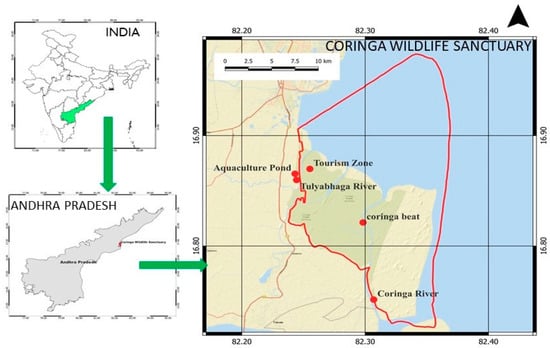
Figure 1.
Map showing the five different study sites in the Coringa Wildlife Sanctuary, Andhra Pradesh, India. [Site 1: Tourism zone, Site 2: Coringa river, Site 3: Tulyabhaga river, Site 4: Coringa beat, Site 5: Aquaculture pond].
In the current study, five different foraging sites of fishing cats were selected, i.e., Site 1: Tourism zone, Site 2: Coringa river, Site 3: Tulyabhaga river, Site 4: Coringa beat, Site 5: Aquaculture pond for the collection of scats of the fishing cat (Figure 1). The selection of these sites was based on the availability and abundance of scats (old and fresh). In addition, personal inquiries were conducted with the village people living adjacent to the mangrove forest. We have enquired about the presence or sighting of the fishing cat and recorded their views, and the sites were finalized to collect the scats for the present study. For each site, six scat samples were selected. The physical structure, age of the scat (days), and pugmark variations were used to differentiate among the different individuals of fishing cats.
2.2. Collection of Scats of Fishing Cat
The scat samples of the fishing cat (Prionailurus viverrinus) were collected from five different sites (Figure 2) using an opportunistic method [14] from March to June 2022. The opportunistic method is conventional, in which the scats were collected from five distinct sites that the fishing cat used as a feeding area. For each site, six scats were collected for the study. The collected scat samples were wrapped in butter paper and transported to the lab in Ziplock covers for further metal analysis.
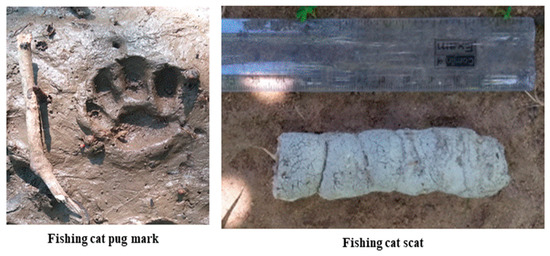
Figure 2.
Pugmark and scat of the fishing cat Prionailurus viverrinus, Coringa Wildlife Sanctuary, India.
2.3. Preparation of Scat Samples for Metal Analysis
Scat samples of the fishing cat were soaked in double distilled water for 24 h. Then, the soaked scats were sieved using a 1 mm sieve and the excess water was removed from the soaked samples using Whatman filter paper. Next, the dehydrated scat samples were transferred to a Petri dish and were focused under a light microscope to identify the prey species present in the scat sample of the fishing cat [15]. Finally, the prey matters, such as fishbone, rodent hair, bird nails, mongoose hair, bird feathers, and the Ctenoid scale of fishes, were found and left for further analysis (Figure 3).
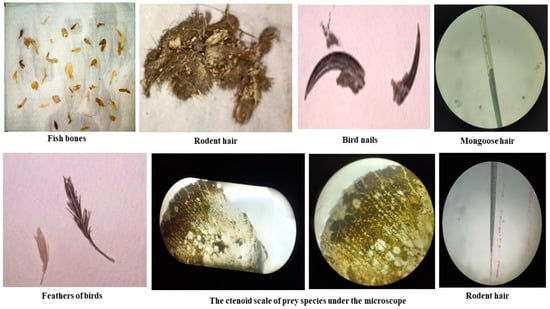
Figure 3.
Prey matters of fishing cats found from their scat samples at five different sites of the study area.
2.4. Digestion of Scats of Fishing Cat
The scats’ length, breadth, and weight were measured and dried using a hot sterilizer for 24 h at 105 °C. The scat remnants were homogenized and weighed using an electronic balance [16]. Five grams of the homogenized dry scat was digested using a microwave digester (Milestone, MLS 1200) with 10 ml of nitric acid (69% grade) for 10 min, and 1 ml of perchloric acid (70% grade) for 5 min [17]. The digested samples were left in a deep freezer until metal analysis, such as Cr, Cu, and Pb, using atomic absorption spectroscopy (AAS) [18,19].
2.5. Quality Control
The steady state of the equipment can be determined by injecting each of the three QC samples. To ascertain the precision of the results, three blank, standard and samples were used for each set of the metal analysis from the scat samples. Standard curves were also prepared for Cr, Cu, and Pb at 05, 1.0, 2.0, 5.0, and 10 ppm. The AAS is fixed to a level of zero for each sample with a blank. The metal results are reported as ppm [1,19].
2.6. Data Analysis
Arithmetic mean and standard error were measured to relate the results of heavy metal contamination. After normality was tested (Shapiro–Wilk), a one-way analysis of variance (ANOVA) was computed to validate the difference in metal concentration among the sites. The analysis was performed using SPSS 25.0, and the level of significance is p < 0.05. The results are inferred by Sokal and Rohl [20].
3. Results
A variety of crustaceans, fishes, birds, rodents, plants, plastics, and unidentifiable prey items were discovered in fishing cat scats (Table 1). The contents of their scat showed various types of consumed prey items, such as shells and carapaces from crustaceans; scales, fins, and bones from fish; feathers, bones, and claws from birds; hair, bone, teeth, and nails from rodents; leaves, grass, prickly spikes, and heartwood from plants; and plastics of varying sizes (Table 1). The one-way ANOVA revealed that the quantity and composition of prey matters showed significant differences among the sites studied (p < 0.05).

Table 1.
Prey species and their composition found in the scats of fishing cat, Coringa Wildlife Sanctuary, Andhra Pradesh, India from March to June 2022 (values are mean and SE; n = 6).
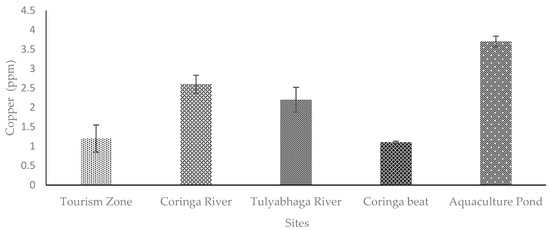
Figure 4.
Level of Cu examined in fishing cat scats from different sites of Coringa Wildlife Sanctuary, Andhra Pradesh, India. [Tourism zone (Site 1), Coringa river (Site 2), Tulyabhaga river (Site 3), Coringa beat (Site 4), and Aquaculture pond (Site 5)]. [Bar indicates mean and the line indicates SE; n = 6].
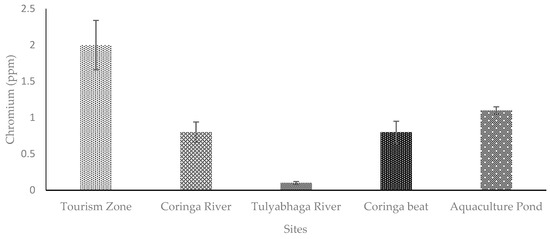
Figure 5.
Level of Cr examined in fishing cat scats from different sites of Coringa Wildlife Sanctuary, Andhra Pradesh, India. [Bar indicates mean and line indicates SE; n = 6].
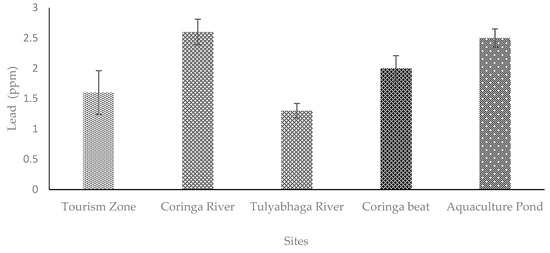
Figure 6.
Level of Pb examined in fishing cat scats from different sites of Coringa Wildlife Sanctuary, Andhra Pradesh, India. [Bar indicates mean and line indicates SE; n = 6].
4. Discussion
The aquatic environment provides sustainable homes for diverse species of fauna and flora throughout their life cycle; however, the majority of the aquatic ecosystem is polluted and damaged by various forms of pollution, with heavy metals being the most damaging [21]. According to research, heavy metals are significantly more harmful than other toxic elements in the aquatic ecosystem [1]. Due to metal contamination, severe detrimental effects have been observed on several aquatic animal species, particularly top predators [22]. The research analyzed the Cu, Cr, and Pb levels in the feces of the fishing cat, which is the main predator in the Coringa Wildlife Sanctuary [4]. Researchers discovered that mammalian feces are the most accurate source for assessing metal concentrations [23]. In fact, heavy metals in carnivores were evaluated utilizing nondestructive procedures in the interest of their welfare and management [24,25]. Similar nondestructive approaches were used to analyze certain metals in other species, such as feathers and egg shells in birds [1,12,17,18,19]. Cu, Cr, and Pb have noteworthy physiological and behavioral effects on a variety of animal species [26,27,28,29,30]. Copper, chromium, and lead were found in higher amounts in the feces of the fishing cat from the Coringa Wildlife Sanctuary than in the feces of other mammal species tested elsewhere in the globe, as determined by the present research.
4.1. Copper (Cu)
Copper is a fundamental nutrient, which is needed by all living things in order to survive. Moreover, copper has distinct physiological activities, particularly regarding the structure and function of amino acids [31]. In contrast, quarrying, melting, granulating, agricultural activities, and the improper disposal of both liquid and solid wastes all contribute to the presence of copper in aquatic environments. Agro-farming operations, biogeochemical cycles, and industrial effluents contribute to Cu reabsorption in aquatic ecosystems [17,26]. The mangrove ecosystem of Coringa Wildlife Sanctuary is threatened by the influx of contaminated water from nearby rivers, canals, aquafarms, factories, and businesses [10]. The present research revealed a higher concentration of Cu in fishing cat scats obtained from the Coringa river, the Tulyabhaga river, the Coringa beat, and Aquaculture pond (Figure 4, Figure 5 and Figure 6). The carnivorous fishing cat dines mostly on fish, birds, rodents, and crabs. Indeed, the Cu is stored in higher concentrations in smaller animals, such as rats, while marine fishes, shorebirds and crustaceans are known to be exposed to a larger amount of Cu [32,33]. Nevertheless, studies indicated that the Godavari river water and the soil sediment of the Coringa mangrove had a greater level of Cu [9,10]. Therefore, it is possible that the fishing cat showed greater level of Cu, which is possibly due to their diet preferences in the mangrove forest.
4.2. Chromium (Cr)
The major sources of Cr in aquatic environments are through the biological factors, petroleum coal, chromium factories, fertilizer companies, metal plate, and leather industries etc. Another source of Cr in wetland environments is by anthropogenic activities in the estuary layers [34]. A study revealed that the Cr is enhanced due to the deposition of wastewater from homes and factories [35]. According to the research, the Cr levels were highest in the fishing cat scat at Site 1 (Tourist zone) of the Coringa Wildlife Sanctuary. Tourists that flock to the sanctuary’s most popular attractions may have taken items made from chromium and added them to this existing element. In addition, fish, crabs, and birds have higher Cr [36]. Moreover, the current study’s research on the food composition of the fishing cat revealed that it forages on fish, crabs, birds, and vegetation (Table 1). As a result, their foraging strategies and choice of prey affect the amount of Cr in fishing cat scats. Coringa Wildlife Sanctuary has been shown to have significant levels (p < 0.05) of metal contamination, particularly Cr [9,10]. Therefore, this might be the reason that the level of Cr was greater in fishing cat scats.
4.3. Lead (Pb)
Pb has several protein functions and is involved in cellular metabolism [31]. Pb in aquatic environments comes from human activities, such as sewage disposal, coal burning, paint production, automobile production, leather processing, oil refining, etc. [37,38]. The present investigation was conducted at the Coringa Wildlife Sanctuary, where water is piped in from the Godavari river and its tributaries through a network of canals that pass through several human-populated areas. Coringa mangrove forest water, sediment, and the Godavari river water have been reported to contain traces of lead [9,10]. Toxic metals may leach out of contaminated water as well as sediment and contaminate aquatic species, including crustaceans, fish, birds, rodents, and plants [39,40,41,42]. The Pb is higher in rats, since they consume a wide variety of plant and animal products, as observed by Way and Schroder [43]. The current study found that the level of Pb in fishing cat scat was in greater concentrations. The diet composition of the fishing cat scat showed that the cat feeds on crustaceans, fishes, birds, and rodents (Table 1). Therefore, the study suggested the level of Pb in the fishing cat through their diet and feeding habits. According to a previous study [44], lead poisoning is a major problem among carnivorous animals. Studies have shown that Pb may have devastating effects on a variety of animal physiological systems [45,46].
Nevertheless, the concentrations of Cr, Cu, and Pb were greater in the fishing cat than the other studied mammals, such as tiger, wild boar, wild cats, deer, rodents, rabbits, nilgai, porcupine, wild cats, etc., [22,23,24,28,43], which is one of the remarkable findings of the study. In addition, the study revealed that the metal concentrations varied significantly (p < 0.05) among the five different sites (Figure 4, Figure 5 and Figure 6). The variations in the level of metals among the sites might be due to the composition of prey species, the size and weight of the prey, and other ecological factors. The concentration of Cr, Cu, and Pb in the fishing cat is above the threshold level, and thus could affect the physiology and behavior of the fishing cats. Studies have stated that severe physiological and behavioral changes have been reported due to the metal’s poison in animals [47,48].
5. Conclusions
The study explored the level of metals, such as Cr, Cu, and Pb, in the vulnerable fishing cat (Prionailurus viverrinus) using scat samples from their feeding and breeding sites of the sanctuary. The fishing cat is a top predator in the Coringa Wildlife Sanctuary and is regarded as an important or keystone species of the sanctuary. However, rigorous studies need to be carried out on the assessment of metals, including other toxic metals which are not covered in this study. Moreover, the metals from water, soil, and their prey species are essentially assessed to achieve knowledge on the pollution and quality of the sanctuary for better management of the vulnerable fishing cat. Furthermore, the authorities should frame guidelines on the discharges of various effluents in the Godavari river, regulations on tourism, and a proper protocol for the outlet of aquafarms for the management of the sanctuary and the wild cat, which purely depends on the sanctuary.
Author Contributions
Conceptualization, T.L.H., K.K. and J.P.; methodology, T.L.H. and K.K.; software, K.K. and J.P.; validation, T.L.H., K.K., M.G. and J.P.; formal analysis, T.L.H. and K.K.; investigation, T.L.H. and K.K.; resources, K.A.A.-G.; data curation, M.N.R., M.G., K.K. and J.P.; writing—original draft preparation, K.K. and J.P.; writing—review and editing, M.G., M.N.R. and K.A.A.-G.; supervision, K.K.; funding acquisition, K.A.A.-G. All authors have read and agreed to the published version of the manuscript.
Funding
Researchers Supporting Project Number (RSP2023R48), the King Saud University, Riyadh, Saudi Arabia.
Institutional Review Board Statement
Not applicable.
Informed Consent Statement
Not applicable.
Data Availability Statement
Not applicable.
Acknowledgments
The authors express their sincere appreciation to the Researchers Supporting Project Number (RSP2023R48), King Saud University, Riyadh, Saudi Arabia. We express our sincere thanks to the Government of Andhra Pradesh Forest Department for giving us permission to carry out the project at Coringa Wildlife Sanctuary, Andhra Pradesh. India. Our Sincere thanks to the Department of Zoology and Wildlife Biology, AVC College, Tamil Nadu, India for providing necessary facilities.
Conflicts of Interest
The authors declare no conflict of interest.
References
- Burger, J.; Tsipoura, N.; Niles, J.; Gochfeld, M.; Dey, A.; Mizrahi, D. Mercury, Lead, Cadmium, Arsenic, Chromium and Selenium in Feathers of Shorebirds during Migrating through Delaware Bay, New Jersey: Comparing the 1990s and 2011/2012. Toxics 2015, 3, 63–74. [Google Scholar] [CrossRef] [PubMed]
- Sandilyan, S.; Kathiresan, K. Decline of mangroves–a threat of heavy metal poisoning in Asia. Ocean Coast. Manag. 2014, 102, 161–168. [Google Scholar] [CrossRef]
- Rao, K.N.; Saito, Y.; Nagakumar, K.C.V.; Demudu, G.; Rajawat, A.S.; Kubo, S.; Li, Z. Palaeogeography and evolution of the Godavari delta, east coast of India during the Holocene: An example of wave-dominated and fan-delta settings. Palaeogeogr. Palaeoclimatol. Palaeoecol. 2015, 440, 213–233. [Google Scholar]
- Malla, G.; Sivakumar, K. The Coringa Mangroves-Realm of the fishing cat. Sanctuary Asia 2014, 34, 60–65. [Google Scholar]
- Malla, G. Ecology and conservation of Fishing Cat in Godavari mangroves of Andhra Pradesh. In Proceedings of the First International Fishing Cat Conservation Symposium, Kathmandu, Nepal, 25–29 November 2015; Volume 45, pp. 25–29. [Google Scholar]
- Mukherjee, S.; Appel, A.; Duckworth, J.W.; Sanderson, J.; Dahal, S.; Willcox, D.H.A.; Rahman, H. Prionailurus viverrinus. The IUCN Red List of Threatened Species. 2016. Available online: https://www.iucnredlist.org/species/18150/221434864 (accessed on 9 February 2023).
- Jnawali, S.R.; Baral, H.S.; Lee, S.; Acharya, K.P.; Upadhyaya, G.P.; Pandey, M.; Shrestha, R. The Status of Nepal’s Mammals: The National Red List Series. Department of National Parks and Wildlife Conservation, Kathmandu, Nepal; IUCN: Gland, Switzerland, 2011.
- Hossain, M.B.; Miazie, M.R.; Nur, A.A.U.; Paul, S.K.; Bakar, M.A.; Paray, B.A.; Arai, T. Assessment of Metal Contamination in Water of Freshwater Aquaculture Farms from a South Asian Tropical Coastal Area. Toxics 2022, 10, 536. [Google Scholar] [CrossRef]
- Hussain, J.; Husain, I.; Arif, M.; Gupta, N. Studies on heavy metal contamination in Godavari river basin. Appl. Water Sci. 2017, 7, 4539–4548. [Google Scholar] [CrossRef]
- Ray, A.K.; Tripathy, S.C.; Patra, S.; Sarma, V.V. Assessment of Godavari estuarine mangrove ecosystem through trace metal studies. Environ. Int. 2006, 32, 219–223. [Google Scholar] [CrossRef]
- Laskowski, R. Are the top carnivores endangered by heavy metal biomagnification? Oikos 1991, 60, 387–390. [Google Scholar] [CrossRef]
- Pandiyan, J.; Jagadheesan, R.; Karthikeyan, G.; Mahboob, S.; Al-Ghanim, K.A.; Al-Misned, F.; Ahmed, Z.; Krishnappa, K.; Elumalai, K.; Govindarajan, M. Probing of heavy metals in the feathers of shorebirds of Central Asian Flyway wintering grounds. Sci. Rep. 2020, 10, 22118. [Google Scholar] [CrossRef]
- Shankar, A.; Salaria, N.; Sanil, R.; Chackaravarthy, S.D.; Shameer, T.T. Spatio-temporal association of fishing cats with the mammalian assemblages in the East Godavari mangrove delta, India. Mammal Study 2020, 45, 303–313. [Google Scholar] [CrossRef]
- De Barba, M.; Waits, L.P.; Genovesi, P.; Randi, E.; Chirichella, R.; Cetto, E. Comparing opportunistic and systematic sampling methods for non-invasive genetic monitoring of a small translocated brown bear population. J. Appl. Ecol. 2010, 47, 172–181. [Google Scholar] [CrossRef]
- Navaneethan, B.; Sankar, K.; Manjrekar, M.; Qureshi, Q. Food habits of tiger (Panthera tigris tigris) as shown by scat analysis in Bandhavgarh Tiger Reserve, Central India. Asian J. Conserv. Biol. 2019, 8, 224–227. [Google Scholar]
- Shin, D.M.; Oh, J.M.; Kim, J. Metal concentrations in Eurasian eagle owl pellets as a function of reproductive variables in Korea. Arch. Environ. Contam. Toxicol. 2018, 74, 298–304. [Google Scholar] [CrossRef]
- Jayakumar, R.; Muralidharan, S. Metal contamination in select species of birds in Nilgiris District, Tamil Nadu, India. Bull. Environ. Contam. Toxicol. 2011, 87, 166–170. [Google Scholar] [CrossRef] [PubMed]
- Pandiyan, J.; Mahboob, S.; Jagadheesan, R.; Elumalai, K.; Krishnappa, K.; Al-Misned, F.; Govindarajan, M. A novel approach to assess the heavy metal content in the feathers of shorebirds: A perspective of environmental research. J. King Saud. Univ. Sci. 2020, 32, 3065–3071. [Google Scholar] [CrossRef]
- Pandiyan, J.; Mahboob, S.; Govindarajan, M.; Al-Ghanim, K.A.; Ahmed, Z.; Al-Mulhm, N.; Krishnappa, K. An assessment of level of heavy metals pollution in the water, sediment and aquatic organisms: A perspective of tackling environmental threats for food security. Saudi J. Biol. Sci. 2021, 28, 1218–1225. [Google Scholar] [CrossRef] [PubMed]
- Sokal, R.R.; Rohlf, F.I. Biometry: The Principles and Practice of Statistics in Biological Research; W.H. Freeman: San Francisco, CA, USA, 1969; 776p. [Google Scholar]
- Ullah, K.; Hashmi, M.Z.; Malik, R.N. Heavy-metal levels in feathers of cattle egret and their surrounding environment: A case of the Punjab province, Pakistan. Arch. Environ. Contam. Toxicol. 2014, 66, 139–153. [Google Scholar] [CrossRef]
- Gupta, V.; Bakre, P.P. Metal contamination in mammalian fauna of Sariska tiger reserve, Alwar, India. J. Ecophysiol. Occup. Health 2012, 12, 43–48. [Google Scholar]
- Gaumat, V.; Bakre, P.P. Mammalian dung as a bioindicator of heavy metal contamination. Proc. Acad. Environ. Biol. 1998, 7, 99–102. [Google Scholar]
- Gupta, V. Mammalian Scat as a Bio-indicator of Heavy Metals Contamination in Western Rajasthan, India. Int. J. Sci. Res. Publ. 2012, 2, 1–7. [Google Scholar]
- Rodríguez-Estival, J.; Ortiz-Santaliestra, M.E.; Mateo, R. Assessment of Eco-toxicological risks to river otters from ingestion of invasive red swamp crayfish in metal contaminated areas: Use of feces to estimate dietary exposure. Environ. Res. 2020, 181, 108907. [Google Scholar] [CrossRef] [PubMed]
- Burger, J.; Gochfeld, M. Metal levels in feathers of 12 species of seabirds from Midway Atoll in the northern Pacific Ocean. Sci. Total Environ. 2000, 257, 37–52. [Google Scholar] [CrossRef] [PubMed]
- Pandiyan, J.; Poiyamozhi, A.; Mahboob, S.; Al-Ghanim, K.A.; Al-Misned, F.; Ahmed, Z.; Manzoor, I.; Govindarajan, M. Assessment of the Toxic Effects of Heavy Metals on Waterbirds and Their Prey Species in Freshwater Habitats. Toxics 2022, 10, 641. [Google Scholar] [CrossRef] [PubMed]
- Johnson, M.S.; Thompson, D.J. Ecotoxicology of copper and cadmium in a contaminated grassland ecosystem.III. Small mammals. J. Apple. Ecol. 1987, 24, 601–614. [Google Scholar]
- Lee, C.S.L.; Li, X.; Shi, W.; Cheung, S.C.; Thornton, I. Metal contamination in urban, suburban and country park soils of Hong Kong: A study based on GIS and multivariate statistics. Sci. Total Environ. 2006, 356, 45–61. [Google Scholar] [CrossRef] [PubMed]
- Malik, R.N.; Zeb, N. Assessment of environmental contamination using feathers of Bubulcus ibis as a biomonitor of heavy metal pollution, Pakistan. Ecotoxicology 2009, 18, 522–536. [Google Scholar] [CrossRef]
- Janssens, E.; Dauwe, T.; Bervoets, L.; Eens, M. Inter and intra-clutch variability in heavy metals in feathers of Great tit nestlings (Parus major) along a pollution gradient. Arch. Environ. Contam. Toxicol. 2002, 43, 323–329. [Google Scholar] [CrossRef]
- Worrall, D.H. Diet of the Dunlin Calidris alpina in the Severn estuary. Bird Study 1984, 31, 203–212. [Google Scholar] [CrossRef]
- Al Sayegh Petkovšek, S.; Kopušar, N.; Kryštufek, B. Small mammals as biomonitors of metal pollution: A case study in Slovenia. Environ. Monit. Assess. 2014, 186, 4261–4274. [Google Scholar] [CrossRef]
- Ghani, A. Effect of chromium toxicity on growth, chlorophyll and some mineral nutrients of Brassica juncea L. Egyptian Acad. J. BiolSci. 2011, 2, 9–15. [Google Scholar]
- Lam, M.H.W.; Tjia, A.Y.W.; Chan, C.C.; Chan, W.P.; Lee, W.S. Speciation study of chromium, copper and nickel in coastal estuarine sediments polluted by domestic and industrial effluents. Mar. Pollut. Bull. 1997, 34, 949–959. [Google Scholar] [CrossRef]
- Catsiki, V.A.; Katsilieri, C.; Gialamas, V. Chromium distribution in benthic species from a gulf receiving tannery wastes (Gulf of Geras—Lesbos island, Greece). Sci. Total Environ. 1994, 145, 173–185. [Google Scholar] [CrossRef]
- Jerez, S.; Motas, M.; Palacios, M.J.; Valera, F.; Cuervo, J.J.; Barbosa, A. Concentration of trace elements in feathers of three Antarctic penguins: Geographical and interspecific differences. Environ. Pollut. 2011, 159, 2412–2419. [Google Scholar] [CrossRef]
- Markowski, M.; Kaliński, A.; Skwarska, J.; Wawrzyniak, J.; Bańbura, M.; Markowski, J.; Bańbura, J. Avian feathers as bioindicators of the exposure to heavy metal contamination of food. Bull. Environ. Contam. Toxicol. 2013, 91, 302–305. [Google Scholar] [CrossRef] [PubMed]
- Lim, H.C.; Posa, M.R.C. Distribution and prey of migratory shorebirds on the northern coastline of Singapore. Raffles Bull. Zool. 2014, 62, 701–717. [Google Scholar]
- Battley, P.F.; Rogers, D.I.; Piersma, T.; Koolhaas, A. Behavioural evidence for heat-load problems in great knots in tropical Australia fuelling for long-distance flight. Emu 2003, 103, 97–103. [Google Scholar] [CrossRef]
- Finkelstein, M.E.; George, D.; Scherbinski, S.; Gwiazda, R.; Johnson, M.; Burnett, J.; Smith, D.R. Feather lead concentrations and 207Pb/206Pb ratios reveal lead exposure history of California condors (Gymnogyps californianus). Environ. Sci. Technol. 2010, 44, 2639–2647. [Google Scholar] [CrossRef]
- Mado-Filho, G.M.; Salgado, L.T.; Rebelo, M.F.; Rezende, C.E.; Karez, C.S.; Pfeiffer, W.C. Heavy metals in benthic organisms from Todosos Santos Bay, Brazil. Braz. J. Biol. 2008, 68, 95–100. [Google Scholar] [CrossRef]
- Way, C.A.; Schroder, G.D. Accumulation of lead and cadmium in wild populations of the commensal rat, Rattus norvegicus. Arch. Environ. Contam. Toxicol. 1982, 11, 407–417. [Google Scholar] [CrossRef]
- Zook, B.C.; Sauer, R.M.; Garner, F.M. Lead poisoning in captive wild animals. J. Wildl. Dis. 1972, 8, 264–272. [Google Scholar] [CrossRef]
- Ogwuegbu, M.O.C.; Muhanga, W. Investigation of lead concentration in the blood of people in the copper belt province of Zambia. J. Environ. 2005, 1, 66–75. [Google Scholar]
- Udedi, S.S. From guinea worm scourge to metal toxicity in Ebonyi State. Nigeria Magazine 2003, 2, 13–14. [Google Scholar]
- Damek-Poprawa, M.; Sawicka-Kapusta, K. Damage to the liver and testis with reference to burden of heavy metals in yellownecked mice from areas around steelworks and zinc smelter in Poland. Toxicology 2003, 186, 1–10. [Google Scholar] [CrossRef] [PubMed]
- Kovalchuk, L.A.; Mikshevich, N.V. Accumulation of heavy metals by small mammals the background and polluted territories of the Urals. Vestn. Zool. 2017, 51, 325. [Google Scholar] [CrossRef]
Disclaimer/Publisher’s Note: The statements, opinions and data contained in all publications are solely those of the individual author(s) and contributor(s) and not of MDPI and/or the editor(s). MDPI and/or the editor(s) disclaim responsibility for any injury to people or property resulting from any ideas, methods, instructions or products referred to in the content. |
© 2023 by the authors. Licensee MDPI, Basel, Switzerland. This article is an open access article distributed under the terms and conditions of the Creative Commons Attribution (CC BY) license (https://creativecommons.org/licenses/by/4.0/).